A Bridge Too Far?
Air Date: Week of September 26, 2003
Producer Alan Weisman leads us on a trip to an island off the coast of Chile that boasts a proud and distinct culture. The Chilean government wants to build a bridge there to boost the economy of the island and the nation. But islanders think that’s a big mistake.
Transcript
CURWOOD: It’s Living on Earth. I’m Steve Curwood.
At the northern end of the archipelago that stretches a thousand miles down Chile toward Cape Horn is an island the size of Puerto Rico, called Chiloé. Chiloé has developed its own mythology and culture, thanks to its isolation. Its folklore, quaint towns, succulent seafood and the picturesque ferry crossing have made it a tourism treasure.
But some fear the island's mystique may soon be lost. For its 2010 bicentennial, Chile wants to build the longest bridge in Latin America, to join Chiloé with the rest of the nation. The government promises faster access to hospitals and easier access for tourists. Yet many islanders claim this bridge isn't really for them, but for a fish – and a foreign fish at that. As part of “Worlds of Difference,” a series by Homelands Productions, Alan Weisman reports.
[MUSIC: SONG BY ROLANDO ALARCÓN]
WEISMAN: A ghost is singing.
[MUSIC]
WEISMAN: His words tell how he drowned when a storm snatched the boat that was taking him to his wedding.
[BIRDS CHIRPING, MUSIC]
WEISMAN: The place where his bride waited in vain is a big green island that hangs like a teardrop off the south coast of Chile, called Chiloé.
[BIRDS CHIRPING]
WEISMAN: On Chiloé, hearing ghosts or seeing spirits is accepted, even expected. There’s La Pincoya, a long-haired nymph in a seaweed skirt whose dance lures the fish. Or El Trauco, the gnarly forest troll who’s to blame when single girls on Chiloé find themselves pregnant. And our unlucky groom is now surely aboard a schooner named El Caleuche .
CÅRDENAS: [IN SPANISH] the Caleuche is a phantom ship. Its crews are drowned sailors, lost at sea. Whenever the fog enshrouds the shore or moves up the rivers, that means El Caleuche is here.
[CÅRDENAS TALKING, SOUND OF WATER, PADDLING]
WEISMAN: For centuries, the phantom ship Caleuche had no shortage of drowned seamen. Chiloé’s original natives, the Mapuche Indians, had only bark canoes to reach their cousins on the mainland, a mile-and-a-half across a windy channel. The sailboats used by settlers sent to this farthest outpost of the Spanish Empire weren’t much safer.
CÅRDENAS: [IN SPANISH] We’re in the Santa Maria de Loreto de Achao church, the oldest wooden church in Chile.
[CÅRDENAS TALKING, SOUND OF CREAKING BOARDS]
WEISMAN: Chiloé historian Renato Cårdenas is descended from a Spanish sea captain who ran aground here in 1613. Stroking his silky gray goatee, Renato explains that this island was so remote that missionaries couldn’t even get nails to build churches
CÅRDENAS: [IN SPANISH] This church was made with wooden pegs, no nails.
WEISMAN: Isolated together, Chiloé’s Spaniards and Mapuches intermingled blood lines and beliefs, and called themselves Chilotes.
[FERRY ARRIVING AT DOCK, WHISTLE]
WEISMAN: In 1958, regular ferry service finally began.
MALE ON FERRY: [IN SPANISH] Renato Cårdenas!
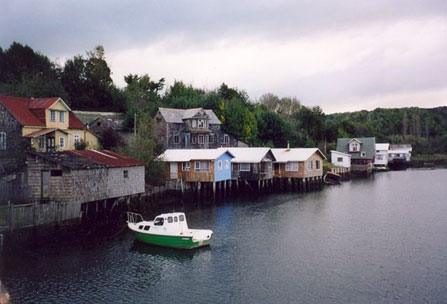 Palitos—houses built on stilts—on the island of Chiloé. (Photo: Alan Weisman)
Palitos—houses built on stilts—on the island of Chiloé. (Photo: Alan Weisman)
WEISMAN: Soon, tourists arrived to try to glimpse El Trauco, and to see stilt houses, and wooden churches built from pegs and interlocking shingles, so charming that they’ve been recognized by UNESCO.
[ACCORDIAN PLAYING]
OYAZUN: [IN SPANISH] The churches are now official world heritage sites. Chiloé also has more than 30 folk festivals every summer.
WEISMAN: Felix Oyazún heads a local development council. He says tourists come for Chilote folklore and music, and a cuisine of 200 native potatoes and huge mussels and oysters. But the enchantment, he says, starts with the crossing.
OYAZUN: [IN SPANISH] Arriving by ferry is like going through a magic door to an island, like none that exists anywhere else in Chile or South America.
[SINGING IN SPANISH, ACCORDIAN PLAYING]
WEISMAN: Which is why he was stunned to hear about Chile’s plan to turn his island into a peninsula. For its bicentennial in 2010, the government wants to build Latin America’s longest suspension bridge, at a cost of a third of a billion dollars. That would turn a 20 minute ferry passage into a three minute car trip.
OYAZUN: [IN SPANISH] It will be a real shock for the tourists. Chiloé needs an airport, a hospital, roads. It would be contradiction to have a gorgeous luxury of a bridge to such a deficient place. The government has to come to its senses.
[SINGING IN SPANISH, ACCORDIAN PLAYING, FERRY ENGINES]
WEISMAN: Nine ferry boats, with four diesels apiece, run constantly between the mainland and the island.
VILLALOBOS: [IN SPANISH]: The ferries serve their function, but they just aren’t enough.
WEISMAN: Businessman Sergio Villalobos leads support for the bridge from the town of Ancud. He thinks the sheer volume of traffic a bridge carries would more than make up for the loss of some romantic tourists.
VILLALOBOS: [IN SPANISH] When the Golden Gate was built, they went from 10 thousand trips a month to 140 thousand vehicles every day.
WEISMAN: And all those customers, he adds, will fortify culture, not harm it.
VILLALOBOS: [IN SPANIH] We’ll train more people to form folklore groups for the tourist flow, like hula professionals in Hawaii, or Mariachis in Mexico. That used to be just for fun, now there are Mariachi schools. We need to do that here. Bridges bring progress, and new industry.
WEISMAN: Ancud could use new industry. This town of 30 thousand used to be Chiloé’s fishing capital, but cod and sea bass are now so depleted that it’s down to one processing plant. Yet, when you mention the jobs the bridge might bring to local fishermen, you don’t get the expected reply.
MALE: [IN SPANISH] It would be worse for us, because traditions would be lost. The magic of the island would be lost. Our mythology would lost.
[PEOPLE TALKING IN SPANISH]
WEISMAN: Bridges form connections, unite communities. Yet all over this island, emotions run high against one that would link Chiloé to the modern world. One reason, say these fishermen, is the belief that it’s not really for Chiloé at all.
MALE: [IN SPANISH] It’s just to benefit the salmon industry...
WEISMAN: In Chile, fishing is fishing, but salmon is an industry. Today, half the salmon U.S. consumers eat comes from here. But 25 years back, there were no salmon in this country.
CÁRDENAS: [IN SPANISH] We are in Curaco de Vélez, an historic place, this is where salmon farming began, not just in Chiloé, but in all Chile.
[BIRDS SINGING, WIND BLOWING THROUGH TREES]
WEISMAN: A lot of us are grateful for farmed salmon. In an age of collapsing sea harvests, groceries and sushi bars everywhere abound with thick orange salmon filets. Maybe you’ve heard that Chile is the world’s second biggest salmon exporter, after Norway. But in these globalized times, that’s a little confusing because half the Chilean companies are owned by Norwegians themselves or their European neighbors. In the 1970s, tests showed that isolated Chiloé had some of the clearest water left on the planet. Soon, European salmon growers were floating giant cages of Atlantic salmon transplanted from Norway in lakes and inlets all around this Pacific island.
[SLOSHING WATER, MEN TALKING IN SPANISH]
WEISMAN: Renato Cårdenas talks to a fisheries technician at a new installation on a bay near Castro, the city where he teaches.
MALE: [IN SPANISH] We have 280,000 fish, around 40,000 fish per cage. In two months, we’ll double.
[WATER SLOSHING, SEAGULLS]
WEISMAN: All those fish, yet only two men are working here. Automated feeders deliver pellets made of ground-up sardines, anchovies and jack mackerel. To keep the salmon coming, Chile has become the world’s second biggest producer of fishmeal.
MALE: [IN SPANISH] A motor pushes food to the cages, so fewer workers are needed and the salmon grow more uniformly. We monitor by camera to make sure they eat everything, so less food is lost.
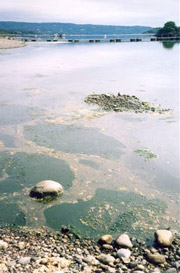 Algae pollution and salmon platforms (Photo: Alan Weisman)
Algae pollution and salmon platforms (Photo: Alan Weisman)
[WATER SLOSHING]
INFANTE: The total sales for the year 2002 were $973 million worth of exports.
WEISMAN: Rodrigo Infante, general manager of the National Salmon Growers’ Trade Association, says Chile is on its way to becoming the world’s number one salmon producer.
INFANTE: We feel the bridge itself will be a positive thing for the island and its people.
WEISMAN: The bridge, he explains, is actually key to a grand plan that goes far beyond Chiloé.
INFANTE: Well, Chile has 55,000 kilometers of coastline and 95 percent of that to the south – plenty, plenty, plenty of areas to develop.
WEISMAN: That southern coastline is a pristine puzzle of islands, fjords, and volcanoes. No road can traverse it. But a bridge to Chiloé would extend the Pan American highway 100 miles farther, creating a gateway to those untapped regions. Chile’s grand vision is fish farms clear down to Tierra del Fuego, to triple salmon production.
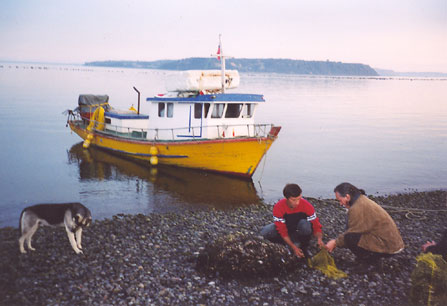 Mussel Cleaning, salmon cages, Calen, Chiloé (Photo: Alan Weisman)
Mussel Cleaning, salmon cages, Calen, Chiloé (Photo: Alan Weisman)
[MEN TALKING IN SPANISH, CLINKING OF MUSSEL SHELLS, DOG BARKING]
WEISMAN: On the eastern shore of Chiloé, Renato Cárdenas and his cousin Pancho gather mussels.
CÅRDENAS: [IN SPANISH] I was born here on the shore. I grew up like algae, like a mollusc. This beach was my playground.
WEISMAN: Behind them rises their hamlet’s wooden church steeple, and hills where teams of oxen plow. In front lie many green islands. And beyond on the mainland, the snowy peaks of the Chilean Andes, golden in the afternoon light.
[SOUND OF CLEANING MUSSELS]
WEISMAN: Just offshore bobs a huge raft of the omnipresent aluminum cages, near a line of abandoned styrofoam floats.
CÅRDENAS: [IN SPANISH] That’s a salmon farm, and that’s the remains of one. They contaminated the bottom so badly, they had to move it.
[DOG YELPING]
WEISMAN: Where they moved it was right atop rich shellfish beds where Renato’s relatives collect. So they’ve had to work a little harder to fill their 30-kilo sacks with two local mussel varieties: small, sweet choros and big, meaty cholgas.
CÅRDENAS: Adelante. Pase. Hola!
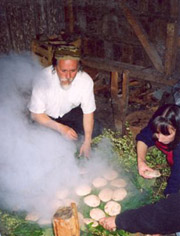 Renato Cårdenas, Curanto bread (Photo: Alan Weisman) Renato Cårdenas, Curanto bread (Photo: Alan Weisman) |
WEISMAN: Inside, three women at a wood stove are grating a heap of yellow and purple potatoes, mixing them with lard and flour, then patting them into rolls.
[WOMEN AND CHILDREN TALKING, SOUND OF TELEVISION] WEISMAN: In truth, there have always been bridges to Chiloé, like the satellite dish that brings the Simpsons in Spanish to the TV the kids watch while their mothers cook. Another leads back to a heritage shared across time and ocean with other Pacific isles, from Easter Island to Polynesia. What they are preparing here would be called luau on Hawaii. On Chiloé, it is curanto. [RUSTLING AND METAL CLANKING] 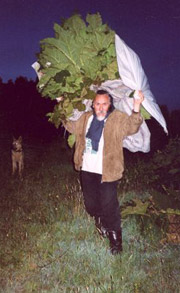 Cárdenas gathers pangue leaves.jpg Caption: Renato Cárdenas gathers pangue leaves. (Photo: Alan Weisman) Cárdenas gathers pangue leaves.jpg Caption: Renato Cárdenas gathers pangue leaves. (Photo: Alan Weisman)
[MEN SPEAKING SPANISH] WEISMAN: They’ll cover the loaves of potato bread and the mounds of mussels, to seal in the steam from the fire-heated rocks. The cooking hole is the same one they’ve been using for generations. [LAUGHING, SOUNDS OF POTATOS FRYING, PEOPLE TALKING IN SPANISH] WEISMAN: It took only an hour for the curanto to cook, but the eating lasts twice as long. Silence descends except for the clatter of mussel shells and the passing of wine bottles. Until Pancho’s accordion and the guitars come out. [ACCORDIAN MUSIC, SINGING] WEISMAN: Sometime past midnight, the music ends. Renato Cårdenas sits with his cousins on the wooden steps of the house his grandfather built. Directly above hang the Milky Way and southern cross, but they shine fainter than they used to. CARDENA: [IN SPANISH] There is no night here anymore. WEISMAN: Offshore, the huge platform of floating salmon cages glares under floodlights. About a year ago, someone reasoned that since salmon feed by sight, by adding lights you could grow them to size in eight months instead of twelve. CARDENA: [IN SPANISH] The world becomes tangled in sound. WEISMAN: Along with the night, tranquility has also vanished. Since little electricity reaches Chiloé’s tiny coastal hamlets, each salmon raft has a droning diesel generator to power its lights. [DIESEL GENERATOR HUMMING] WEISMAN: Chilote legends say that Chiloé was formed when an angered sea serpent, Quaiquai, made the waters rise, flooding the land. Taking pity, the land serpent Tenten lifted the mountains and the islands, so people could seek refuge. CÅRDENAS: [IN SPANISH] About a decade ago, a big storm here, destroyed half the salmon cages. Masses of free salmon, swimming in the open. The people’s explanation was that Quaiquaí was responding to what they are doing to the sea. This was Quaiquaí’s revenge. WEISMAN: It’s well-known on Chiloe that the center column of the new bridge will rest on a rock that used to be an island, until an earthquake in 1960 submerged it. Or maybe that was Quaiquaí, too. [MAN SPEAKING SPANISH, BIRD CHIRPING] WEISMAN: The spirits won’t let the bridge happen either, says one of Renato’s cousins. [MAN SPEAKING SPANISH, BIRD CHIRPING] WEISMAN: Renato smiles. Maybe not, he replies. [ACCORDIAN PLAYING] WEISMAN: For Living on Earth, on the island of Chiloé, I’m Alan Weisman reporting. [ACCORDIAN PLAYING] CURWOOD: Our story on Chiloé is part of “Worlds of Difference,” a Homelands Productions series funded in part by the Rockefeller Foundation and the Corporation for Public Broadcasting. For pictures and more information on Chiloé, visit our website, livingonearth.org. [ACCORDIAN PLAYING] Links
|





